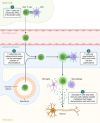Vascular multiple sclerosis: addressing the pathogenesis, genetics, pro-angiogenic factors, and vascular abnormalities, along with the role of vascular intervention
- PMID: 37811110
- PMCID: PMC10553029
- DOI: 10.1097/MS9.0000000000001177
Vascular multiple sclerosis: addressing the pathogenesis, genetics, pro-angiogenic factors, and vascular abnormalities, along with the role of vascular intervention
Abstract
Dysfunction in the epithelium, breakdown of the blood-brain barrier, and consequent leukocyte and T-cell infiltration into the central nervous system define Vascular Multiple Sclerosis. Multiple sclerosis (MS) affects around 2.5 million individuals worldwide, is the leading cause of neurological impairment in young adults, and can have a variety of progressions and consequences. Despite significant discoveries in immunology and molecular biology, the root cause of MS is still not fully understood, as do the immunological triggers and causative pathways. Recent research into vascular anomalies associated with MS suggests that a vascular component may be pivotal to the etiology of MS, and there can be actually a completely new entity in the already available classification of MS, which can be called 'vascular multiple sclerosis'. Unlike the usual other causes of MS, vascular MS is not dependent on autoimmune pathophysiologic mechanisms, instead, it is caused due to the blood vessels pathology. This review aims to thoroughly analyze existing information and updates about the scattered available findings of genetics, pro-angiogenetic factors, and vascular abnormalities in this important spectrum, the vascular facets of MS.
Keywords: cerebral venous insufficiency; endothelial dysfunction; inflammation; vascular multiple sclerosis.
Copyright © 2023 The Author(s). Published by Wolters Kluwer Health, Inc.
Conflict of interest statement
The authors declare that they have no conflicts of interest.Sponsorships or competing interests that may be relevant to content are disclosed at the end of this article.
Figures


References
-
- Korn T. Pathophysiology of multiple sclerosis. J Neurol 2008;255:2–6. - PubMed
-
- Gold R, Wolinsky JS. Pathophysiology of multiple sclerosis and the place of teriflunomide. Acta Neurol Scand 2011;124:75–84. - PubMed
-
- Caprio MG, Russo C, Giugliano A, et al. . Vascular disease in patients with multiple sclerosis: a review. J Vasc Med Surg 2016;4:1. 10.4172/2329-6925.1000259 - DOI
-
- Correale J, Villa A. The blood–brain–barrier in multiple sclerosis: functional roles and therapeutic targeting. Autoimmunity 2007;40:148–160. - PubMed
-
- Minagar A, Jy W, Jimenez JJ, et al. . Multiple sclerosis as a vascular disease. Neurol Res 2006;28:230–235. - PubMed
Publication types
LinkOut - more resources
Full Text Sources
